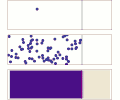File:DiffusionMicroMacro.gif
From formulasearchengine
Jump to navigation
Jump to search
DiffusionMicroMacro.gif (360 × 300 pixels, file size: 402 KB, MIME type: image/gif, looped, 60 frames, 6.5 s)
This file is from Wikimedia Commons and may be used by other projects. The description on its file description page there is shown below.

|
File:DiffusionMicroMacro.svg is a vector version of this file. It should be used in place of this GIF file when not inferior.
File:DiffusionMicroMacro.gif → File:DiffusionMicroMacro.svg
For more information, see Help:SVG.
|
Summary
| DescriptionDiffusionMicroMacro.gif |
English: Diffusion from a microscopic and macroscopic point of view. Initially, there are solute molecules on the left side of a barrier (magenta line) and none on the right. The barrier is removed, and the solute diffuses to fill the whole container. Top: A single molecule moves around randomly. Middle: With more molecules, there is a clear trend where the solute fills the container more and more evenly. Bottom: With an enormous number of solute molecules, the randomness is gone: The solute appears to move smoothly and systematically from high-concentration areas to low-concentration areas, following Fick's laws.
Image is made in Mathematica, source code below. |
| Date | |
| Source | Own work |
| Author | Sbyrnes321 |
Licensing
| Public domainPublic domainfalsefalse |
| I, the copyright holder of this work, release this work into the public domain. This applies worldwide. In some countries this may not be legally possible; if so: I grant anyone the right to use this work for any purpose, without any conditions, unless such conditions are required by law. |
<< Mathematica source code >>
(* Source code written in Mathematica 6.0, by Steve Byrnes, 2010.
I release this code into the public domain. Sorry it's messy...email me any questions. *)
(*Particle simulation*)
SeedRandom[1];
NumParticles = 70;
xMax = 0.7;
yMax = 0.2;
xStartMax = 0.5;
StepDist = 0.04;
InitParticleCoordinates = Table[{RandomReal[{0, xStartMax}], RandomReal[{0, yMax}]}, {i, 1, NumParticles}];
StayInBoxX[x_] := If[x < 0, -x, If[x > xMax, 2 xMax - x, x]];
StayInBoxY[y_] := If[y < 0, -y, If[y > yMax, 2 yMax - y, y]];
StayInBoxXY[xy_] := {StayInBoxX[xy[[1]]], StayInBoxY[xy[[2]]]};
StayInBarX[x_] := If[x < 0, -x, If[x > xStartMax, 2 xStartMax - x, x]];
StayInBarY[y_] := If[y < 0, -y, If[y > yMax, 2 yMax - y, y]];
StayInBarXY[xy_] := {StayInBarX[xy[[1]]], StayInBarY[xy[[2]]]};
MoveAStep[xy_] := StayInBoxXY[xy + {RandomReal[{-StepDist, StepDist}], RandomReal[{-StepDist, StepDist}]}];
MoveAStepBar[xy_] := StayInBarXY[xy + {RandomReal[{-StepDist, StepDist}], RandomReal[{-StepDist, StepDist}]}];
NextParticleCoordinates[ParticleCoords_] := MoveAStep /@ ParticleCoords;
NextParticleCoordinatesBar[ParticleCoords_] := MoveAStepBar /@ ParticleCoords;
NumFramesBarrier = 10;
NumFramesNoBarrier = 50;
NumFrames = NumFramesBarrier + NumFramesNoBarrier;
ParticleCoordinatesTable = Table[0, {i, 1, NumFrames}];
ParticleCoordinatesTable[[1]] = InitParticleCoordinates;
For[i = 2, i <= NumFrames, i++,
If[i <= NumFramesBarrier,
ParticleCoordinatesTable[[i]] = NextParticleCoordinatesBar[ParticleCoordinatesTable[[i - 1]]],
ParticleCoordinatesTable[[i]] = NextParticleCoordinates[ParticleCoordinatesTable[[i - 1]]]];];
(*Plot full particle simulation*)
makeplotbar[ParticleCoord_] :=
ListPlot[{ParticleCoord, {{xStartMax, 0}, {xStartMax, yMax}}}, Frame -> True, Axes -> False,
PlotRange -> {{0, xMax}, {0, yMax}}, Joined -> {False, True}, PlotStyle -> {PointSize[.03], Thick},
AspectRatio -> yMax/xMax, FrameTicks -> None];
makeplot[ParticleCoord_] :=
ListPlot[ParticleCoord, Frame -> True, Axes -> False, PlotRange -> {{0, xMax}, {0, yMax}}, Joined -> False,
PlotStyle -> PointSize[.03], AspectRatio -> yMax/xMax, FrameTicks -> None]
ParticlesPlots =
Join[Table[makeplotbar[ParticleCoordinatesTable[[i]]], {i, 1, NumFramesBarrier}],
Table[makeplot[ParticleCoordinatesTable[[i]]], {i, NumFramesBarrier + 1, NumFrames}]];
(*Plot just the first particle in the list...Actually the fifth particle looks better. *)
FirstParticleTable = {#[[5]]} & /@ ParticleCoordinatesTable;
FirstParticlePlots =
Join[Table[makeplotbar[FirstParticleTable[[i]]], {i, 1, NumFramesBarrier}],
Table[makeplot[FirstParticleTable[[i]]], {i, NumFramesBarrier + 1, NumFrames}]];
(* Continuum solution *)
(* I can use the simple diffusion-on-an-infinite-line formula, as long as I correctly periodically replicate the
initial condition. Actually just computed nearest five replicas in each direction, that was a fine approximation. *)
(* k = diffusion coefficient, visually matched to simulation. *)
k = .0007;
u[x_, t_] := If[t == 0, If[x <= xStartMax, 1, 0], 1/2 Sum[
Erf[(x - (-xStartMax + 2 n xMax))/Sqrt[4 k t]] - Erf[(x - (xStartMax + 2 n xMax))/Sqrt[4 k t]], {n, -5, 5}]];
ContinuumPlots = Join[
Table[Show[
DensityPlot[1 - u[x, 0], {x, 0, xMax}, {y, 0, yMax},
ColorFunctionScaling -> False, AspectRatio -> yMax/xMax,
FrameTicks -> None],
ListPlot[{{xStartMax, 0}, {xStartMax, yMax}}, Joined -> True,
PlotStyle -> {Thick, Purple}]],
{i, 1, NumFramesBarrier}],
Table[
DensityPlot[1 - u[x, tt], {x, 0, xMax}, {y, 0, yMax},
ColorFunctionScaling -> False, AspectRatio -> yMax/xMax,
FrameTicks -> None],
{tt, 1, NumFramesNoBarrier}]];
(*Combine and export *)
TogetherPlots =
Table[GraphicsGrid[{{FirstParticlePlots[[i]]}, {ParticlesPlots[[i]]}, {ContinuumPlots[[i]]}},
Spacings -> Scaled[0.2]], {i, 1, NumFrames}];
Export["test.gif", Join[TogetherPlots, Table[Graphics[], {i, 1, 5}]],
"DisplayDurations" -> {10}, "AnimationRepititions" -> Infinity ]
Captions
Add a one-line explanation of what this file represents
ব্যাপন প্রক্রিয়া
Items portrayed in this file
depicts
16 January 2010
image/gif
File history
Click on a date/time to view the file as it appeared at that time.
| Date/Time | Thumbnail | Dimensions | User | Comment | |
|---|---|---|---|---|---|
| current | 15:41, 7 March 2012 |  | 360 × 300 (402 KB) | wikimediacommons>Dratini0 | Just removed the white last fram for aesthetic purposes, and prologed the display time of the last frame to mark the reatart of the animation. |
File usage
The following page uses this file:
Retrieved from "https://en.formulasearchengine.com/wiki/File:DiffusionMicroMacro.gif"

